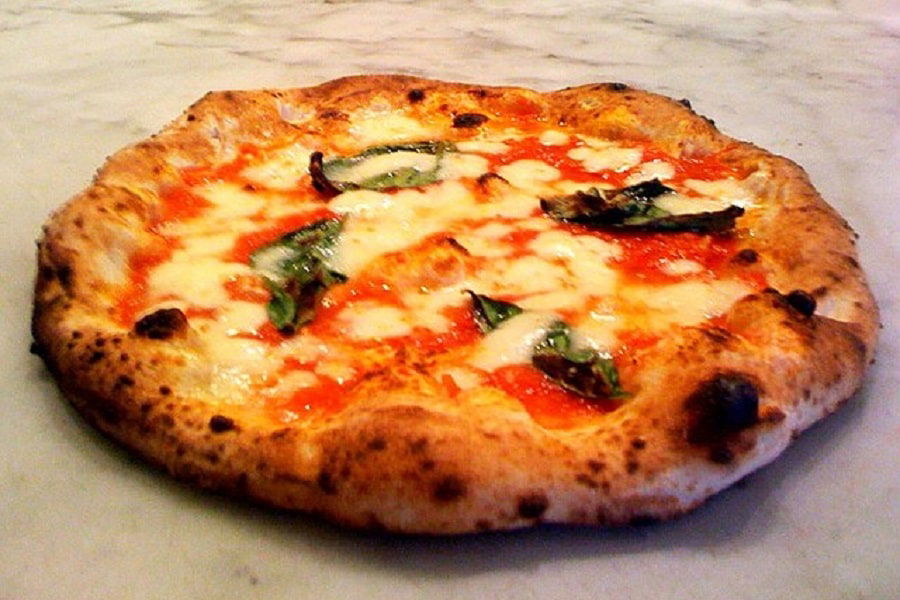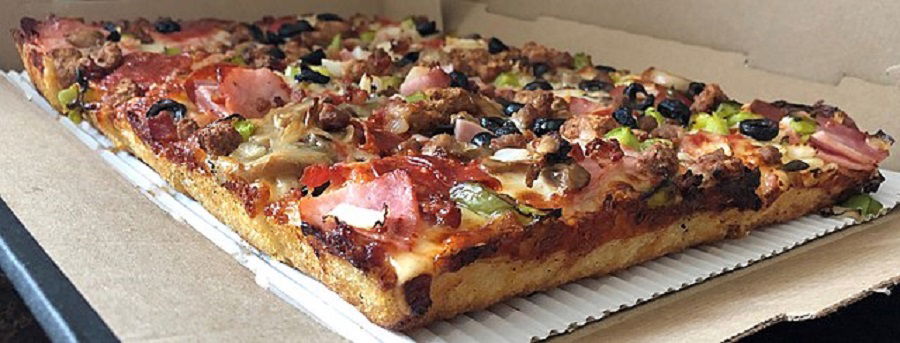Pizza, a baked flatbread with toppings of cheese, meat, and vegetables, is probably the most popular food eaten around the world now. Ask an ordinary person on the street, “Who invented pizza?” Their response would probably be “the Italians.” And this would be the correct response, in a way. But the roots of pizza can be traced back much further than modern-day Italy.
Table of Contents
Who Invented Pizza and When Was Pizza Invented?

Who invented pizza? The easy answer would be that pizza was invented in Naples, Italy, by Raffaele Esposito in the 19th century CE. When King Umberto and Queen Margherita visited Naples in 1889, Esposito made the first premier pizzas in the world for the monarchs.
It was the queen’s first foray into genuine Italian food since the monarchy in those days exclusively consumed French cuisine. Pizza was considered a peasant’s food. Queen Margherita was particularly impressed by one which had all the colors of the Italian flag on it. Today, we know this as pizza Margherita.
Thus, we can say that it was an Italian chef from the small town of Naples who invented pizza. But it’s more complicated than that.
Which Country Invented Pizza?
Long before Esposito set out to impress the king and queen, the ordinary people in the Mediterranean region were eating a form of pizza. Nowadays, we have all kinds of fusion food. We serve ‘naan pizza’ and ‘pita pizza’ and pat ourselves on the back for having invented something. But actually, those are not that far off from the ancestors of pizza. Pizza was, after all, just a flatbread before it became a worldwide sensation.
Ancient Flatbreads
The history of pizza begins in the ancient civilizations of Egypt and Greece. Thousands of years ago, civilizations all over the world were making leavened flatbreads of some kind or the other. Archaeological evidence has unearthed leavened bread in Sardinia as far back as 7000 years ago. And it is not at all surprising that people began to add flavor by adding meats and vegetables and fungi to it.
The closest thing to pizza was found in what are the Mediterranean countries today. The people of ancient Egypt and Greece ate flat bread baked in clay or mud ovens. These baked flatbreads were often topped with spices or oils or herbs – the very ones that are still added to pizza now. The people of ancient Greece made a dish called plakous. It was a flatbread topped with cheese, onion, garlic, and herbs. Sounds familiar?
The soldiers of Emperor Darius of ancient Persia made flatbread on their shields, which they topped with cheese and dates. Thus, fruit on pizza cannot even be called a strictly modern innovation. This was in the 6th century BC.
A reference to food very like pizza can be found in the Aeneid by Virgil. In Book III, the Harpy queen Celaeno prophecies that the Trojans will not find peace until hunger forces them to eat their tables. In Book VII, Aeneas and his men eat a meal of round flatbreads (like pita) with toppings of cooked vegetables. They realize these are the ‘tables’ of the prophecy.

History of Pizza in Italy
In around 600 BCE, the town of Naples started off as a Greek settlement. But by the 18th century CE, it had become an independent kingdom. It was a thriving city close to the coast and was notorious among Italian cities for having a very high population of poor workers.
These workers, especially the ones who lived closest to the bay, often lived in one-room houses. Much of their living and cooking was done out in the open since there just wasn’t any space in their rooms. They needed some inexpensive food that they could make and eat quickly.
Thus, these workers came to eat flatbreads topped with cheese, tomatoes, oil, garlic, and anchovies. The higher classes thought of this food as disgusting. It was considered a street food for poor people and did not become a kitchen recipe until much later. The Spanish had brought tomato from the Americas by this time, so fresh tomatoes were used on these pizzas. The use of tomato sauce came much later.
READ MORE: Who Discovered America: The First People Who Reached the Americas
Naples became part of Italy only in 1861 and it was a couple of decades after this that pizza was officially ‘invented.’

For Whom Was Pizza ‘Invented’?
As stated earlier, Raffaele Esposito was credited with inventing pizza as we know it. It was in 1889 that King Umberto I of Italy and Queen Margherita visited Naples. The queen expressed a wish to taste the best food available in Naples. The royal chef recommended that they try the food of Chef Esposito, who was the owner of Pizzeria Brandi. It had earlier been called Di Pietro Pizzeria.
Esposito was delighted and served the queen three pizzas. These were a pizza topped with anchovies, a pizza topped with garlic (pizza marinara), and a pizza topped with mozzarella cheese, fresh tomatoes, and basil. Queen Margherita is said to have loved the last one so much, she gave it a thumbs up. Chef Esposito proceeded to name it Margherita after her.
This is the popularly quoted story about the invention of pizza. But as we can see with Chef Esposito, pizza and pizzerias existed in Naples long before that. Even in the 18th century, the city had certain shops that were known as pizzerias which served something quite similar to the pizzas we eat today.
Even the Margherita pizza predated the queen. The famous writer Alexandre Dumas described a number of pizza toppings in the 1840s. The most famous pizzas in Naples were said to be the pizza marinara, which could be traced back to the 1730s, and the very pizza Margherita, which could be traced back to 1796-1810 and which had a different name back then.
Thus, it is slightly more correct to say Queen Margherita of Savoy and Raffaele Esposito popularized pizza. If the queen herself could eat poor people’s food, then perhaps it was respectable after all. But pizza had existed in Naples since the Europeans became familiar with tomatoes and began putting tomatoes on their flatbreads.

Why Is Pizza Called Pizza?
The word ‘pizza’ can be first traced back to a Latin text from Gaeta in 997 CE. Gaeta was a part of the Byzantine Empire at the time. The text says that a certain tenant of a property is to give the bishop of Gaeta twelve pizzas on Christmas Day and another twelve on Easter Sunday.
There are several possible sources for the word. It could be derived from the Byzantine Greek or Late Latin word ‘pitta.’ Still known as ‘pita’ in modern Greek, this was a flatbread that was baked in an oven at a very high temperature. It sometimes had toppings. This could be traced back further to the ancient Greek word for ‘fermented pastry’ or for ‘bran bread.’
Another theory is that it comes from the dialectical Italian word ‘pinza’ meaning ‘clamp’ or ‘pinze’ meaning ‘pliers’ or ‘forceps’ or ‘tongs.’ Perhaps this is a reference to the instruments used to make and bake a pizza. Or perhaps it refers to their root word ‘pinsere,’ meaning ‘to pound or stamp.’
The Lombards, a Germanic tribe that invaded Italy in the 6th century CE, had the word ‘pizzo’ or ‘bizzo.’ It means ‘mouthful’ and could have been used to mean ‘snack.’ Some historians have also said that ‘pizza’ can be traced back to ‘pizzarelle,’ which was a kind of Passover cookie eaten by Roman Jews after returning from the synagogue. It might also be traced back to the Italian bread, paschal bread.
When pizza came to the United States, it was first compared to a pie. This was a mistranslation, but it became a popular term. Even now, many Americans think of modern pizza as a pie and call it such.

Pizza Around the World
The history of pizza is not simply a question of who invented pizza in the first place. It also involves the popularization of pizza around the world. Children and youngsters in various countries will reach for a pizza rather than other foods that are offered to them now. And we can credit the United States for much of this.
The first international fame came with tourists arriving in Naples at the end of the 19th century. As the world opened up and people began traveling, they also began exploring foreign cultures and food. They bought pizza from street vendors and seamen’s wives and carried home tales of this delicious tomato pie. When the American soldiers came home after World War II, they had become great fans of pizza. They advertised its value to their friends and family. And as Italian immigrants began moving to America, they carried the recipes with them.
Modern pizza came to be created in American kitchens. It was seen as an Italian treat and was sold by street vendors in American cities. Gradually, they began to use tomato sauce on the pizzas instead of fresh tomatoes, making the process simpler and faster. With the opening of pizzerias and fast food chains, America popularized pizza all over the world.
Canadian Pizza
The first pizzeria in Canada was Pizzeria Napoletana in Montreal, opened in 1948. The authentic Napoletana or Neapolitan pizza has some specifications to be followed. It must be hand-kneaded and not rolled or made by any mechanical means. It must be less than 35 centimeters in diameter and an inch in thickness. It must be baked in a domed and wood-fired pizza oven.
Canada got its first pizza ovens in the 1950s and pizza began to gain more and more popularity with the common people. Pizzerias and restaurants serving common Italian food like pasta, salads, and sandwiches in addition to pizza opened all over the country. Fast food chains also began to serve sides with pizza, like chicken wings and fries with poutine.
READ MORE: Who Invented the Sandwich and Where Did the Sandwich Come From?
The most common type of pizza in Canada is the Canadian pizza. It is usually prepared with tomato sauce, mozzarella cheese, pepperoni, bacon, and mushrooms. The addition of these last two ingredients makes this pizza unique.
An extremely odd preparation that may commonly be found in Quebec is the pizza-ghetti. This is a dish of half a pizza with spaghetti on the side. Some variations even put the spaghetti on the pizza, under the mozzarella. While both pizza and spaghetti are technically Italian dishes, this particular recipe might make Italians recoil in horror.
A little-known fact is that the Hawaiian pizza, with its toppings of pineapple and ham, was actually invented in Canada. The inventor was neither Hawaiian nor Italian, being a Greek-born Canadian named Sam Panapoulos. The name Hawaiian was chosen after the brand of canned pineapple that he used. Since then, whether pineapple belongs on pizza or not has become a global controversy.

America Latches Onto Pizza
Of course, the world knows pizza because of the United States of America. The first pizzeria to open in America was Gennaro Lombardi’s Pizzeria in 1905 in New York. Lombardi made ‘tomato pies,’ wrapped them in paper and a string, and sold them to factory workers in the vicinity of his restaurant for lunch.
A conflicting story says that Giovanni and Gennaro Bruno were serving Neapolitan pizzas in Boston in 1903 and the latter opened the first pizzeria in Chicago. Throughout the 1930s and 40s, pizza joints cropped up in different parts of the country. Pizzas were originally referred to as tomato pies to make them familiar and palatable to the locals. Different styles of pizza that have since become famous, like the Chicago Deep Dish and the New Haven Style Clam Pie, cropped up during this time.
Thus, pizzerias have existed in America since the first decade of the 1900s. But it was after World War II and after the war veterans had already gained a taste for Italian food that pizza really became big. Even Eisenhower was extolling the virtues of pizza. In the 1950s, several pizzerias, with brick ovens and large dining booths appeared in many neighborhoods.
Pizza chains like Pizza Hut and Domino’s grew huge in the United States and then exploded into franchises all over the world. There were also hundreds of smaller chains and restaurants. Pizza being one of the easiest foods to pick up and take home for a weeknight meal, it became a staple among both busy individuals and large families. The availability of frozen pizza in supermarkets made this an extremely convenient meal. Thus, it is one of the most widely consumed dishes in America today.
The most popular toppings for pizza in the United States include mozzarella cheese and pepperoni. Constant competition among smaller restaurants, all serving pizza, guarantees a very high quality of American pizza.

Argentinian Italian Immigrants
Argentina too, significantly enough, saw a lot of Italian immigrants at the end of the 19th century. Many of these immigrants from Naples and Genoa opened what were called pizza bars.
The Argentinian pizza has a typically thicker crust than the traditional Italian variety. It also uses more cheese. These pizzas are often served with faina (a Genoese chickpea pancake) on top and with Moscato wine. The most popular kind is called ‘muzzarella,’ topped with triple cheese and olives.
Styles of Pizza
Many different styles have been invented during the history of pizza. Most of these are American, although even now the most popular kind is the thin-crust Neapolitan style that originated in Naples and traveled all over the world.
Thin Crust Pizza

The Neapolitan pizza, the original Italian pizza, is a thin-crust pizza that immigrants from Naples took to different parts of the world. The popular New York-style pizza is based on this. The art of making Naples-style pizza is considered one of the intangible cultural heritages by UNESCO. The Neapolitan pizza, when taken to Argentina, developed a slightly thicker crust called ‘media masa’ (half dough).
The New York-style pizza is a large, hand-tossed, thin-crust pizza that originated in New York City in the early 1900s. It has minimal toppings and the crust is crispy along the edges but soft and thin at the center. Cheese pizza, pepperoni pizza, meat lover’s pizza, and veggie pizza are some of the most common varieties.
The characteristic feature of this pizza is that it can be easily folded while eating, so the person can eat it one-handed. This makes it very convenient as a fast food item, much more so than the other American favorite – the Chicago deep dish.
Chicago Deep Dish Pizza

The Chicago-style pizza was first developed in and around Chicago and is also referred to as a deep dish because of its cooking style. It is baked in a deep pan, thus giving the pizza very high edges. Loaded with lots of cheese and a chunky sauce made with tomatoes, this greasy and delicious pizza was invented in 1943.
Pizza has been served in Chicago for quite some time, but the first place to serve deep-dish pizzas was Pizzeria Uno. The owner, Ike Sewell, is said to have come up with the idea. This is contested by other claims. Uno’s original pizza chef, Rudy Malnati, has been credited with the recipe. Another restaurant called Rosati’s Authentic Chicago Pizza claims to have been serving this kind of pizza since 1926.
The deep dish is much more like a traditional pie than a pizza, with its raised edges and stuffings under the sauce. Chicago also has a kind of thin-crust pizza which is much crispier than its New York counterpart.
Detroit and Grandma Style Pizzas

Both the Detroit and Grandma-style pizzas aren’t round at all but rectangular in shape. The Detroit pizzas were originally baked in industrial, heavy, rectangular steel trays. They were topped with Wisconsin brick cheese, not the traditional mozzarella. This cheese caramelizes against the sides of the tray and forms a crispy edge.
They were first invented in 1946 in a speakeasy owned by Gus and Anna Guerra. It is based on a Sicilian recipe for pizza and is somewhat similar to another Italian dish, focaccia bread. The restaurant was later renamed Buddy’s Pizza and the ownership changed. This style of pizza was called Sicilian style pizza by locals as late as the 1980s and only became popular outside of Detroit in the 2010s.
The Grandma Pizza came from Long Island, New York. It was a thin, rectangular pizza baked at home by Italian mothers and grandmothers who did not have a pizza oven. It is also often compared to Sicilian pizza. On this pizza, the cheese goes in before the sauce and it is cut into small squares rather than wedges. The cooking equipment is simply a kitchen oven and a standard sheet pan.
Calzones

Whether a calzone can even be called a pizza can be debated. It is an Italian, oven-baked, folded pizza and is sometimes called a turnover. Originating in Naples in the 18th century, calzones can be stuffed with a variety of things, from cheese, sauce, ham, vegetables, and salami to eggs.
Calzones are easier to eat while standing or walking than a pizza slice. Thus, they are often sold by street vendors and at lunch counters in Italy. They can sometimes be confused with the American stromboli. However, stromboli are usually cylindrical in shape while calzones are shaped like crescents.
Fast Food Chains
While Italy is credited with inventing pizza, we can thank the Americans for popularizing pizza all over the world. With the appearance of pizza chains like Pizza Hut, Domino’s, Little Caesar’s, and Papa John’s, pizza was being mass-produced in huge numbers and was available in most countries in the world.
The first Pizza Hut opened in Kansas in 1958 and the first Little Caesar’s in Michigan in 1959. This was followed by Domino’s, originally called Dominick’s, the next year. In 2001, Pizza Hut delivered a 6-inch pizza to the International Space Station. So pizza has come a long way in the last few decades.
With the arrival of the delivery system, people did not even need to step out of their houses to eat pizza. They could simply call and have it delivered. Automobiles and cars were a big boon to all of these fast-food chains.
With various toppings and combinations, each catering to the food habits and culture prevalent in the country, these chains have made pizza a global food. Thus, Naples and Italy may have been the birthplace of pizza. But America was its second home.
The Americans would be quite justified in thinking of pizza as one of their national foods, no less than the Italians. Over 70,000 stores exist in the United States today, all selling pizza. About half of these are individual stores.
In Summary
Thus, in conclusion, it was the Italians who invented pizza. But an event like that does not exist in a vacuum. The 19th-century Italians were not the first ones to come up with the dish, even though they may have taken it to heights never before imagined. The dish did not finish its evolution there. People all over the world have adapted it to their own cuisines and cultures, in manners that might horrify the Italians.
The dish, the methods of preparing it, and the ingredients used in it are all constantly changing. Thus, pizza as we know it, can be credited to a number of people around the world. Without all their contributions, we would never have had this spectacular and extremely satisfying dish.